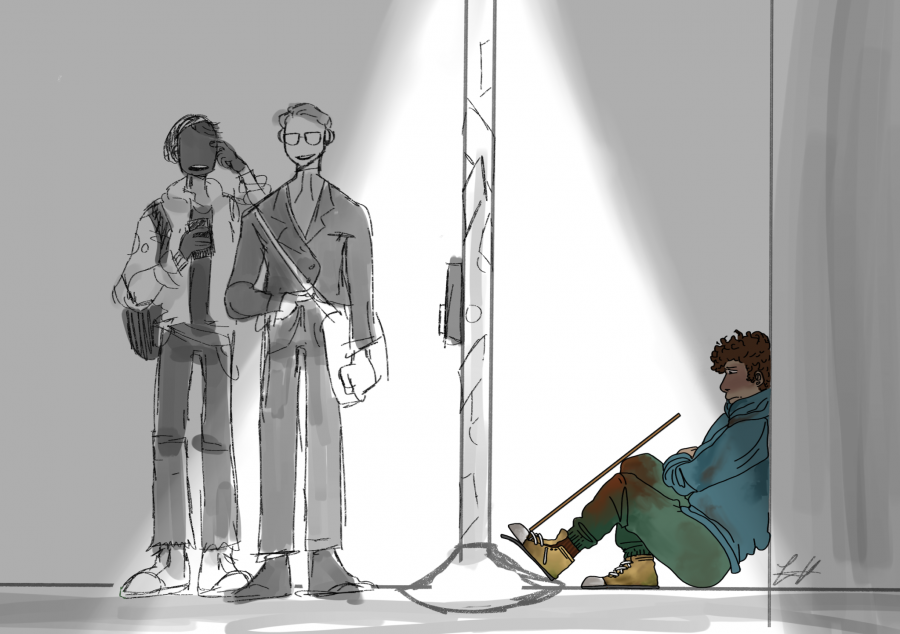*The names in this article have been changed by request of the interviewees
Homeless people are often stereotyped as lazy, jobless blights in society. The reality is much more complicated.
Those who live on the street experience hardships that are difficult to even imagine, let alone survive.
I recently volunteered at a number of night rescue van drives hosted by the Seattle’s Union Gospel Mission, an organization dedicated to helping Seattle’s homeless. In the night van, we drove around Seattle providing essentials like food, water, socks and blankets to those most vulnerable.
While serving and talking to the homeless, many opened up about their lives and the unfortunate situations that put them on the streets.
Several triggering factors came up repeatedly: broken relationships, substance abuse, mental health struggles, domestic violence, and income shortages.
Janie, formerly homeless and currently on the staff of UGM, shared her experience as a survivor of domestic violence at the hands of her husband. This abuse forced her out of her house and onto the streets.
After years of living on the streets, she remarried. However, the traumatic experience of her previous marriage and the fear of recurring abuse, caused her second marriage to fail.
To repress the memories of trauma, she became a heavy drug and alcohol user. First becoming addicted to marijuana, Janie later became dependent on cocaine.
Her 30-year struggle with drug and alcohol addiction limited her ability to hold on to a job. During that time she lacked proper housing.
Union Gospel Mission gave her hope and a second chance. They helped her get into a rehabilitation program, provided her with food and shelter and helped her heal. Now, as an employee of UGM she helps others who are struggling as she once did.
That same night, I also met Lisa, a woman in her mid 40s. Lisa’s boyfriend suffered from bipolar disorder and schizophrenia and because of his illnesses, he became involved with street crime. He was also reluctant to take medication long-term because he was ashamed of his illness and had minimal access to mental health care.
Lisa explained how extremely difficult it was to keep her boyfriend safe and out of crime. She felt that the bad choices that he had made and continued to make were not his own, but driven by his illness.
In trying to support her boyfriend, Lisa struggled to make ends meet. The couple eventually resorted to staying at friend’s houses, but soon even their closest friends turned them away. Without any other resources, Lisa and her boyfriend were forced to live on the streets.
Lisa and Janie’s stories are one of thousands. Often, the people on the streets wind up there because of difficulty accessing medical care for mental illness and a lack of a strong, supportive community.
Later that night, the rescue van took the volunteers to a youth homeless encampment.
Next to a freeway exit, countless tarps and tents were lined up against the roadside. When we pulled up with the rescue van, kids from ages 14 to 18 came out of the tents to get food and warm blankets.
Our driver explained that the vast majority of homeless children turn to the streets because of domestic abuse or a desire for rebellious freedom. For many, avoiding rules, doing what they want, when they want away from their parents seems to be the best way of life.
Other teens are sexually or physically abused at home and have no choice but to run away to escape the danger.
According to a statistic from the National Conference of State Legislatures, “46 percent of runaway and homeless youth reported being physically abused, 38 percent reported being emotionally abused, and 17 percent reported being forced into unwanted sexual activity by a family or household member.”
The homeless youth hope to find community of other adolescents like themselves on the streets, but they are likely to end up in an equally dangerous environment where they are easy targets for predators.
Another man, Ben, shared multiple devastating experiences from living near homeless encampments. As winter approached and temperatures lowered, he witnessed constant death among the homeless population.
Along with the ever present rain, Seattle’s winter temperatures frequently drops below freezing. Those on the streets have no place to sleep with a heating system and are forced to stay out in inclement weather.
Ben revealed that he has often seen dead bodies just lying on the side of the streets.
Another story Ben shared was about a relationship between an abusive homeless father and his son. Over the course of a year, Ben witnessed the father constantly verbally abusing his son. Although he did not see any physical abuse, Ben could infer that it occurred as well.
One day, he woke to the sound of an ambulance. Wondering what had happened, Ben rushed outside to see and realized that the son had committed suicide.
World homelessness is a major issue. Politicians often categorize the homeless as a population lacking in work ethic, that if “these people” just got a job and stopped being lazy, they wouldn’t be such a drain on society.
However, research finds that the cause of homelessness is hardly so simple. The truth is that any of us, if born into the same circumstances and facing the same lack of resources with no social net of support, could easily find ourselves in danger of being forced to live on the streets. The only way to tackle this issue is to change our views and attitudes against those on the streets.
We need to recognize that the causes of homelessness are numerous, varied, and complicated. We need to recognize that the solutions to alleviate homelessness also need to be varied and multifaceted.
A single mother fleeing with her children from an abusive spouse has very different needs from a drug-addicted man with mental health issues. Only by offering proper services to the appropriate subgroup will the solution be effective to help these people out of their situation.
Society must provide stronger education about the impact of drugs and provide greater access to mental health services, drug rehabilitation and trauma treatment programs. Similarly, civic and urban planning has to provide more land to be used for much needed low income housing. More programs also need to be developed to transition willing homeless individuals off the streets, and provide safe housing for victims of domestic violence.
There is a lot of social stigma against those suffering on the streets.The blame game helps no one and prevents positive progress on a deeply complicated problem. While society waits for the homeless to take action and get themselves out of poverty, it fails to realize that change will only occur when new, comprehensive perspectives and solutions develop, and help is given to those in need.















